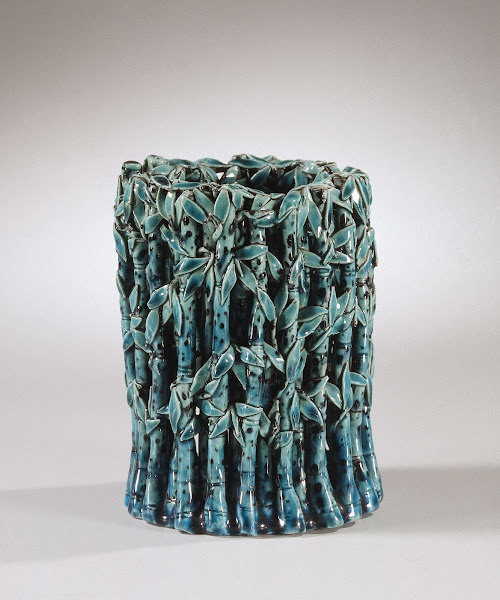Monochromes
Monochromes are ceramic works glazed in a single colour. Glaze has both a practical and an aesthetic function: it waterproofs the object while also furnishing it with decorative colour. The ceramics in the exhibition come from various regions of China, date from different periods and served a variety of purposes. China has a long tradition of monochromes both as functional objects and as collector’s items.
Colour
 Anoniem, Penselenpot, China, ca. 1700 - ca. 1724. Rijksmuseum Amsterdam, inv. Nr. AK-MAK-571. Bruikleen van de Vereniging van Vrienden der Aziatische KunstThe colour of the glaze is typical of the region and time in which the monochrome was made. The first green ceramics were produced only in Southeast China during the Han dynasty in the ninth and tenth centuries. Azure ceramics were made in the south, while the north was famous for pure white glaze. Red glaze was coloured using copper, which was first used in Jingdezhen in the 15th century. The assortment of colour was widened by the introduction of European pigments in the 18th century, and experimentation at the Imperial glassworks in Beijing and the porcelain workshops in Jingdezhen.
Anoniem, Penselenpot, China, ca. 1700 - ca. 1724. Rijksmuseum Amsterdam, inv. Nr. AK-MAK-571. Bruikleen van de Vereniging van Vrienden der Aziatische KunstThe colour of the glaze is typical of the region and time in which the monochrome was made. The first green ceramics were produced only in Southeast China during the Han dynasty in the ninth and tenth centuries. Azure ceramics were made in the south, while the north was famous for pure white glaze. Red glaze was coloured using copper, which was first used in Jingdezhen in the 15th century. The assortment of colour was widened by the introduction of European pigments in the 18th century, and experimentation at the Imperial glassworks in Beijing and the porcelain workshops in Jingdezhen.
The exhibition of monochromes is running until October 15th in the Asian Pavilion of the Rijksmuseum
The Rijksmuseum is starting a new feature highlighting a small exhibition at the Rijksmuseum. Next up: the lithographs of Henri de Toulouse-Lautrec.

